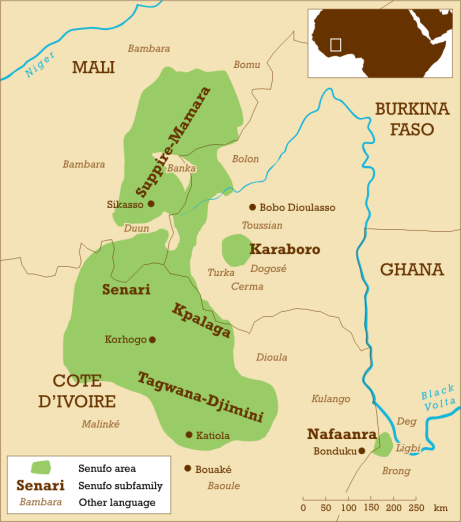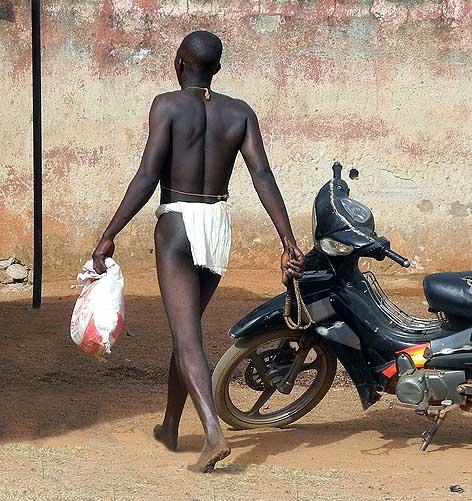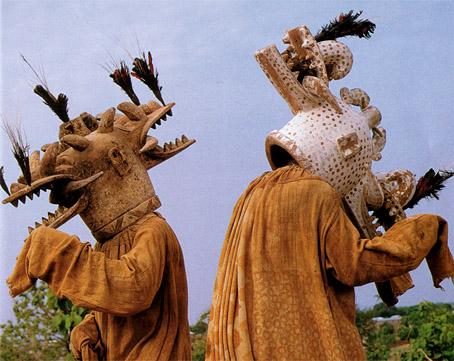
The Senufo people are a group of West African ethnolinguistic people – a group of people that are connected by their common culture and language – that are presently residing in regions like the northern Ivory Coast, the southeastern part of Mali, the western part of Burkina Faso and a subgroup that is located in the northwestern part of Ghana. Before they broke apart and were scattered around the western part of Africa, they were within a strong kingdom known as the Kenedougou kingdom, and they were famously known for their handicrafts, which usually featured their religious and cultural beliefs. Just like in many cultures in Africa, the Senufo people believe that there’s always an overtone of spiritual prominence within the physical world. This article will specifically explore the Poro society's transition from childhood to adulthood. The journey from childhood to adulthood doesn’t just involve a shift in the age of an individual. It is a profound secret that involves the spiritual transition of a Senufo youth, and this article will clarify this secret that’s being passed from generation to generation.
The Initiation Process into the Poro Society
The Poro Society is a secret society whose main objective is to guide and teach young boys to be well-respected men in their society. A source called this process “to walk the path of Poro”, and during this process, the young boys go through rigorous mental and physical training, learn the customs of their people, and undergo instructions on the responsibilities of being an adult. This initiation process helps to preserve the Senufo folklore and prepare the Senufo youth for adult life. The process itself usually takes three stages, and each stage takes a period of seven years to complete, which is normally marked by ceremonies involving circumcision, isolation, instructions, and the use of masks. The Poro initiates can be identified by the small loincloths around their waists and the white cotton caps on their heads.

A group of young initiates of the same grade is called colobele, and the initiation process begins after they are snatched away from their mother’s hut by masquerades in the middle of the night. This symbolizes the process that they undergo to leave their mothers and prepare for adulthood, but before snatching them from their beds, older members of the Poro society usually prepare a place for the initiates in a secret grove. This place is known as the sinzanga, and it’s usually located at the edge of the village in a secluded area. Initiates are said to stay there until they are ready to be full members of the community. Poro initiation begins after the child undergoes circumcision – that is after they were snatched from their beds – and has gone through the process of healing. During this process, the child stays among his peers, and they are said to usually apply kaolin (protective chalk) on their faces and bodies to ward off evil spirits. The circumcision is known to symbolize the death of the initiates’ childhood.
After this process, they are then known as Poro initiates and are instructed in the work of Poro, otherwise known as the work for old mother/ancient mother, a deity known as the protector of Poro initiates. During their stay at the Sinzanga, the young initiates are forbidden to enter the village or talk to anyone outside of the members of the Poro society, and if they meet any relative on their way to work for Poro, they are to pass them without acknowledging them.
“The work for old mother” is very important in the Poro society because it pertains to those teachings that honour the old mother and their ancestors, for example, dancing the masks. Due to how secretive the Poro society can be, most things that are taught within the grove stay within the grove, but dancing the mask involves a masquerade display during occasions. However, dancing the mask in the Poro society means more than is seen during these occasions. Young initiates are taught the rituals and meanings behind the masks, which deepens the meaning behind every performance and every mask that is worn. For example, the kponyungo (sometimes called the firespitter) is used to guide the deceased soul of a high-ranking Poro member to the ancestral realm to prevent them from lingering in the village. Dancing the mask is one of the teachings that is taught to young initiates in the ongoing work for old mother, but the teachings are not done in the normal mentor-to-mentee manner.

Normally, there are additional colobeles in the groove, and young initiates (often aged 7 to 12) learn from the colobele above them. It could be compared to a school, except in this context, the new students learn from the older ones, resulting in the transmission of knowledge exclusively obtained from previous colobeles. Cultural knowledge is not transmitted by oral lessons, guidelines, or myths. Colobeles who were initiates before the new ones pass them back and forth in a secret metaphorical language, which is frequently followed by a corresponding ritual. These activities may appear small and unimportant in and of themselves, but they are performed much like a day-to-day conversation in a general context that engages both the learner and the teacher to practise and discuss simultaneously. Although an elder Poro is usually present to supervise and monitor the new initiates.
The highlight of an initiate’s initiation process is their final graduation as a finished man. As previously stated, the initiation process goes through three stages: the ritual death, which is the first stage; the spiritual regeneration, which normally involves the integration of the initiate into the Poro community; and the final stage, graduation, which is also known as the adult phase. During this phase, the ceremonies that are held usually help deepen the initiates’ understanding of their traditional myths and religion, their interpretation of the special language, and also, they are usually bestowed a secret name.
The initiates are then certified members of the Poro society, and the elders of the Poro society can delegate ruling authority to them, allowing them to make decisions and be consulted on political, religious, or social issues. Traditionally, any male who does not graduate from Poro is considered a boy by the Senufo people and is barred from participating in community activities.
Are Initiates Specially Chosen to Be Part of the Poro Society?
The Poro society is a secret society that is known to initiate every young boy in the Senufo community, although there is one activity that is not officially part of the Poro but is reported to be done in preparation for being part of the Poro society. It is known as the hoeing competition, a competition that is held for young men belonging to the age group that will be initiated in the next few years. It is believed that this competition demonstrates a young man's capacity to get through the initiation process. Although it’s not mandatory, winning this competition usually increases your social standing in society.
Challenges and Contemporary Problems Undergone by the Poro Society in Today’s World
- Reduced relevance in the face of city responsibilities
The skills and knowledge given during the initiation process appear simple in comparison to today's problems, which include earning a living and navigating life in the city.
- Religious beliefs
The high influx of Islam in Senufo communities has resulted in a decrease in participation among Senufo youths due to a vague or diminished understanding of the spiritual significance of the ritual or a misinterpretation of traditional practices, whereas Christians in the Senufo community believe the practice is pagan.
- Education and Western influences
The age grade for schooling corresponds to the age at which children today attend school, which limits participation because many parents prefer sending their children to school over sending them on a long-year journey to a secret society to participate in an initiation process that many consider to be outdated.
Reference
- Christa Neuenhofer, “Poro Initiation Ceremony in Korhogo, Northern Cote D’Ivoire (Ivory Coast),” PBase, accessed June 27, 2025, https://pbase.com/neuenhofer/poro_initiation_ceremony_in_korhogo_cote_ivoire.
- Kathy Curnow, “Chapter 3.4 Art and Youth Initiation,” in The Bright Continent: African Art History, https://pressbooks.ulib.csuohio.edu/bright-continent.
- Kwekudee, "Senufo People: West Africa`s Ancient Artistic Tribe with Unique Secret Societies for Transmission of History, Knowledge and Traditions," Trip Down Memory Lane (blog), March 29, 2013, https://kwekudee-tripdownmemorylane.blogspot.com/2013/03/senufo-people-west-africas-ancient.html.
- Oyindamola Depo Oyedokun, "Poro and Sande: The Secret Societies of West Africa," Africa Rebirth (blog), April 30, 2025, https://www.africarebirth.com/poro-and-sande-the-secret-societies-of-west-africa/.
- “Poro society,” in Encyclopedia of African Religion, edited by Molefi Kete Asante and Ama Mazama (Thousand Oaks, CA: SAGE Publication, Inc., 2009), 532-533, https://doi.org/10.4135/9781412964623.n333.
- “Senufo”, Africa 101 Last Tribes, accessed June 27, 2025, https://www.101lasttribes.com/tribes/senufo.html.
- :Senufo”, Wikipedia, last modified June 9, 2025, https://en.wikipedia.org/wiki/Senufo_people.
- Stephanie Van Bramer, "Learn More: Senufo Firespitter Mask," African Art Collection, Pacific Lutheran University, https://www.plu.edu/africanartcollection/masks/firespitter/learn-more-firespitter/ (accessed June 27, 2025).
- Susan Elizabeth Gagliardi, “Senufo Arts and Poro Initiation in Northern Cote d’Ivoire,” in Heilbrunn Timeline of Art History (New York: The Metropolitan Museum of Art, 2000-). http://www.metmuseum.org/toah/hd/poro/hd_poro.htm (January 2010).
- Till Forster, “Senufo Masking and the Art of Poro,” African Arts 26, no. 1 (January 1993): 30.









